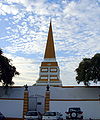- Moinhos Castle
-
Moinhos Castle or Castle of São Cristóvão, also referred to as Fort of São Luís is a castle in Angra, Terceira Island in Azores. "Moinhos" means "Mills" in Portuguese, testimony to the mill that gave it its common name.
History
The first fort in the archipelago was built between the 1460s and 1470s, by the founder of Angra, Álvaro Martins. It would become a fortification of modest proportions, in the current Alto da Memória, in a dominant position over the valley, river and the town harbour, still following the late-medieval military designs: rather high, inside the earth, away from the sea. The slope of that elevation, had an artificial river running, for with the power of its waters, move the wheels of the mills that were built on its course. This fact has made the place being popularly known as Moinhos Castle meaning "Mills" castle.
Although expected to receive the donation of these areas in 1474, he was donated the Captaincy of Praia. The first Captain-major of the Captaincy of Angra, João Vaz Corte-Real found no reason to continue the defensive work.
Years later, the island was attacked by Castilian sailors that initially landed in Angra and then on Praia. For this reason, in 1482, the Infanta Dona Beatriz, who ruled the islands on behalf of her son, the Captain-Major Dom Diogo, in a letter to Álvaro Martins, warned that Castilian vessels were haunting the seas of the Azores, sending to the island Pedro Anes Rebelo, as a provider of fortifications, to guide him as Captain-major of Praia in the fortification of his village. Anes Rebelo came to wed on the island, a niece of the wife of João Vaz Corte-Real, Captain-major of Angra, having completed the construction of the Castle of São Cristóvão in 1493, of which he was the first governor.
In 1495, the Alcaidaria-mor of the castle was given to the Captain-major of Angra itself, who lived there for a while, but later placed there another respectful person, with salary and title of Lieutenant, and with it the obligation to live there. The annexation of the Alcaidaria-mor of the castle to the captaincy, could explain the name of São Cristóvão, when the construction of the Castelo de São João Baptista do Monte Brasil, the Captain-major was the marquis Cristóvão de Moura.
In the context of the Portuguese Restoration War, the artillery of the Castle of São Sebastião attacked with success the Castle of São Filipe, surrounded by the forces of Terceira. After its strategic role was lost, its dependencies were used as the gunpowder storehouse of Angra, that were transferred there from the Praça Velha, for security reasons.
The property was donated to the City of Angra in 1839 to give rise to a promenade. Thus, on May 20 of 1844, work began on the demolition of the old walls, for the construction of a memorial in honour of Pedro IV of Portugal, whose foundation stone was placed on March 3 of 1845, reportedly the same rock in which the monarch first stepped on equal day and month in 1832, while disembarking in the harbour of Angra.
Gallery
Categories:- Wikipedia articles needing cleanup after translation
- Castles in Portugal
- Angra do Heroísmo
- Portuguese forts
Wikimedia Foundation. 2010.




